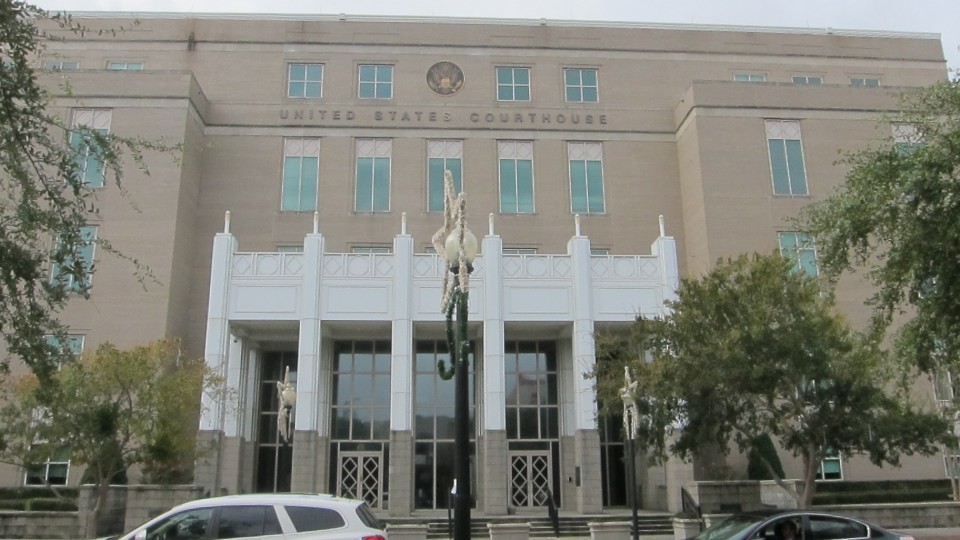Getting back into the fold
- November 30, 2015
- / Shannon Nickinson
- / community-dashboard

The U.S. District Courthouse in Pensacola. Photo credit: Shannon Nickinson
Beginning this month, federal prisoners seeing their prison sentences shortened are returning to communities — including the Pensacola metro area.
The release is due to reforms in federal sentencing guidelines for drug offenses; as CNN reported this month, it led to the biggest federal inmate release on record on Nov. 1.
Among that group of 6,000 federal prisoners released early through sentencing reform efforts were 46 in the Northern District of Florida, which includes the Pensacola metro area.
“To be honest, the federal system is a little behind the curve” in sentencing reform, said U.S. District Chief Judge Casey Rodgers, “because it is consuming huge portions of the (Bureau of Prisons) budget.
“We say $30,000 a year on average to house one federal inmate,” she says.

U.S. District Chief Judge Casey Rodgers has been honored for her work with the re-entry program in the Pensacola area.
By the numbers, Pensacola received 16 such prisoners; Panama City 18; Tallahassee seven; and Gainesville, five, according to data from the court. It is important to reintegrate these people into the community.
Public safety — as measured by the crime rate — is one of 16 metrics in the Studer Community Institute's Pensacola Metro Dashboard that helps gauge the quality of life in a community. The dashboard, created with the University of West Florida, is a set of educational, economic and social benchmarks to track the well-being of the community.
How we got here
The explosion in the federal prison population can be traced to the 1980's with the Sentencing Reform Act.
U.S. District Chief Judge Casey Rodgers says that data shows the federal prison population from 1980 to 2012 increased 800 percent, due in large part to tougher drug sentences linked in that Reform Act.
“Congress did away with parole,” Rodgers said. “This is important because when Congress did away with parole they enacted the Sentencing Reform Act, which was truth in sentencing. You were going to serve your entire sentence.”
Parolees are supervised by court in the federal system, rather than by a parole board, which used to be part of the Department of Justice. In the state system, parole officers are part of the Department of Corrections.
The DOJ and the court system are funded differently in Congress. “We're not even in the same subcommittees for appropriation purposes,” Rodgers says.
There hasn’t necessarily been an increase in the court’s budget to match the volume of new people they will have to supervise.
There's also an initiative by the Obama Administration to commute the sentences for certain offenders, as part of the Smart on Crime initiative.
These are people who have to have served 10 years on their sentence but they can't have any significant criminal history before they went to prison.
Through The Clemency Project, attorneys across the country are assigned to handle these cases.
“These are what you would consider your nonviolent drug offenders,” Rodgers said. “If they have any violence in their history, they're not eligible to be considered.”
Rodgers has seen directly the impact that mandatory sentencing rules have.
“ I've sentenced people to life in prison who were low rungs on the conspiracy ladder but because they had two prior possession cases that could have been 10 or 15 years old, they got mandatory life,” she said. “(Because) that's the mandatory minimum.”
“I've had a number of cases where the top players in a conspiracy end up getting less time than the low rung mule or courier because they had the information to play the game with the US Attorney's office to cooperate, which is a good thing, you want that,” Rodgers said. “But this person down here, they didn't know enough because they weren't involved enough. The guy who's way more culpable gets a lighter sentence than the low rung people.”
Amendment 782 — referred to as “drugs minus 2” — adjusted federal sentencing guidelines on the drug quantity table down two levels.
“This is the third amendment in a line of amendments that has been addressed to the disparity in drug weight,” Rodgers said. “This one applied across the board to all drugs and it changed the calculation for all drugs….The crack cocaine/powder cocaine disparity started all of this.”
The sentencing commission decided a year ago to lower maximum sentences for nonviolent drug offenders and to make the change retroactive, with the inmate releases effective Nov. 1, 2015. Sentences were reduced an average of 18 percent, the commission said.
The state expected to receive the largest number of inmates is Texas, with 2,829, followed by by Florida at 1,200 and Iowa at 785.
Rick Dye, who works with the Re-Entry Alliance of Pensacola, said the community needs to prepare for these former inmates and help them find their place in society.
“These men and women have paid their punishment,” Dye says. “They want to renew the semblance of some life they had and move ahead. To do that, it’s going to take our community to be prepared.
“One of the things employers can do, is to see it’s so much less expensive to give a guy a job instead of giving a guy a jail cell,” Dye says.
Finding help in the community
The explosion in the federal prison population can be traced to the 1980's with the Sentencing Reform Act.
Rodgers says that data shows the federal prison population from 1980 to 2012 increased 800 percent, due in large part to tougher drug sentences linked in that Reform Act.
That increase strained the resources of the Bureau of Prisons, raised concerns about disparity between black and white defendants and ultimately led to the reform effort now under way.
Dye says it is likely that the newly released men and women are likely to be people with community ties that will help them get on their feet again.
“They’ll cut their teeth on a fairly functional group of men,” Dye says. “After that, it probably will get more stressful as it relates to these needs these men will have in terms of resources. (And) there’s going to be a lot more of them over time.”
REAP and RESTORE
Re-Entry Alliance Pensacola submitted a project request for $2.5 million through the Escambia RESTORE process to create a Conservation Corps.
The project is based on the Civilian Conservation Corps model of the 1930s under President Franklin Roosevelt’s New Deal.
The CCC was a public works effort that created a natural resource program in every state. It also created much-needed jobs. Rick Dye, one of the leaders of REAP, noted that the project ranked 24th of 125 projects submitted by the October deadline.
According to the project application, the Escambia Conservation Corps would work with local governments to identify short-term projects on public lands that can use low-skilled labor. It would include deferred maintenance projects, under-funded or unfunded projects.
REAP would manage the Conservation Corps in partnership with the Student Conservation Association and Pathways for Change. It is an effort that dovetails with Dye’s Willing Workers effort, which provides supervision and guidance to ex-inmates as they seek work in home repair and improvement projects.
REAP often steps into that void for recently released inmates who may not have the network of friends and family who can help make the transition back into the real world easier — and for the better.
“When they come out of incarceration, they go down two paths,” Dye says. “One goes back to their family or relatives, where they have a good support mechanism, and they’re able to get back in the community through relationships of family members.
“The other path takes them into the same associations they had before,” Dye said. “We try to intervene before they get out and begin working with them at that point.”
REAP’s client intervention program works to develop a relationship with a soon-to-be-released person before they come out. That includes working on counseling, housing or medical resources as well as getting to work on education or work skills they may need to update.
It is something Dye says has been under way with the Escambia County Jail with an initial class of seven people. “Our last one gets out Dec. 15,” he says.
Rodgers says that the efforts of groups such as REAP are crucial to helping ex-offenders make what can be a difficult return back into society.
“These are people who have enormous challenges and have had their entire lives. Enormous challenges,” she says. “It's our job to address those challenges so that they can be successful because it benefits everyone. To ignore that is not responsible.”

 CivicCon launches with a look at good growth in cities
CivicCon launches with a look at good growth in cities
 Building stronger brains one baby, one parent at a time
Building stronger brains one baby, one parent at a time
 SCI debuts commercial on Early Learning City
SCI debuts commercial on Early Learning City
 Entrecon: World class speakers and an opportunity to sharpen skills
Entrecon: World class speakers and an opportunity to sharpen skills
 PYP Quality of Life survey 2017
PYP Quality of Life survey 2017
 EntreCon Pensacola 2016: A look back
EntreCon Pensacola 2016: A look back
 Leadership tip: getting better employee takeaways
Leadership tip: getting better employee takeaways
 Leadership tip: be interested instead of interesting
Leadership tip: be interested instead of interesting
 Leadership tip: delivering difficult messages
Leadership tip: delivering difficult messages
 Brain Bags boost Arc, Early Childhood Court programs
Brain Bags boost Arc, Early Childhood Court programs